
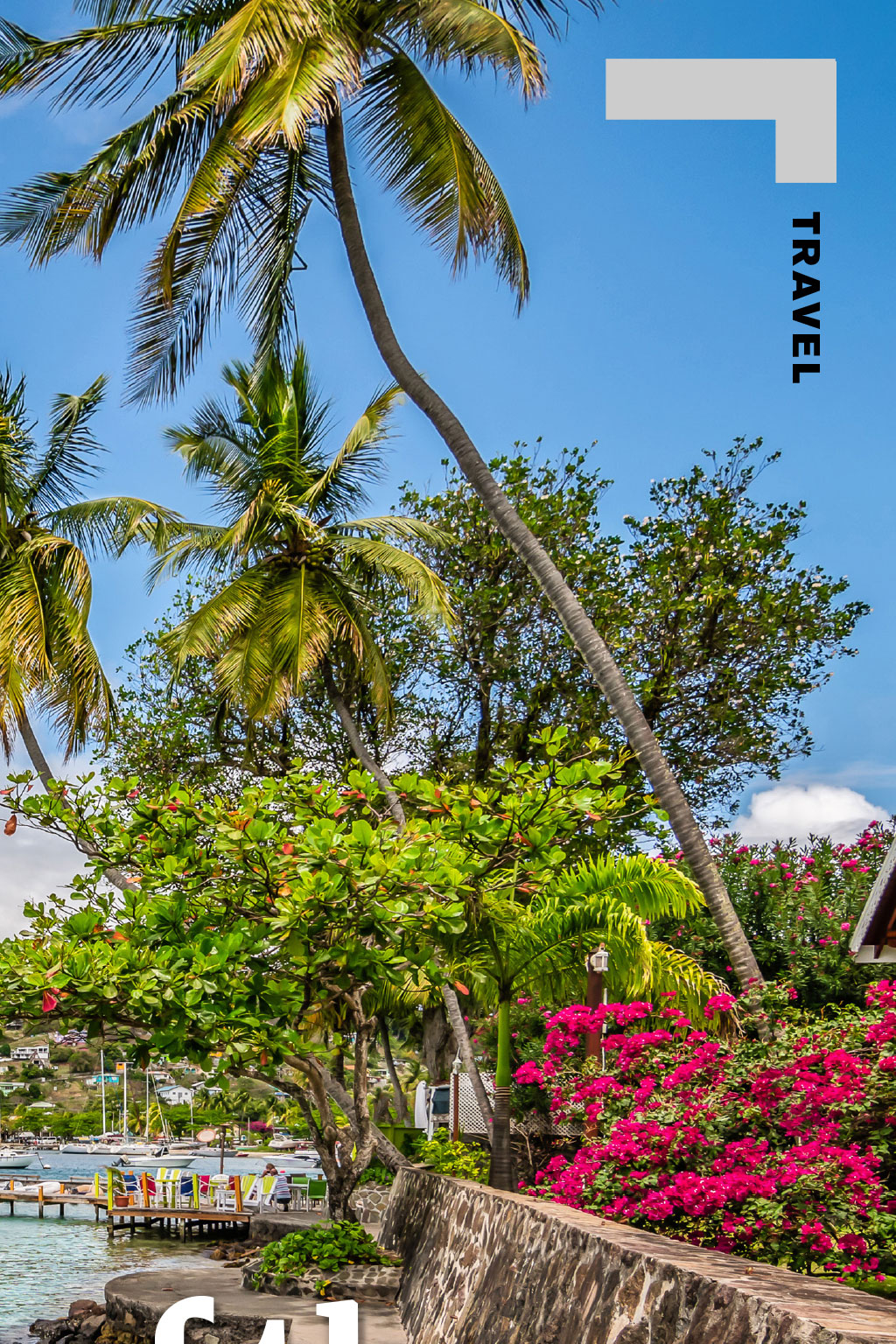
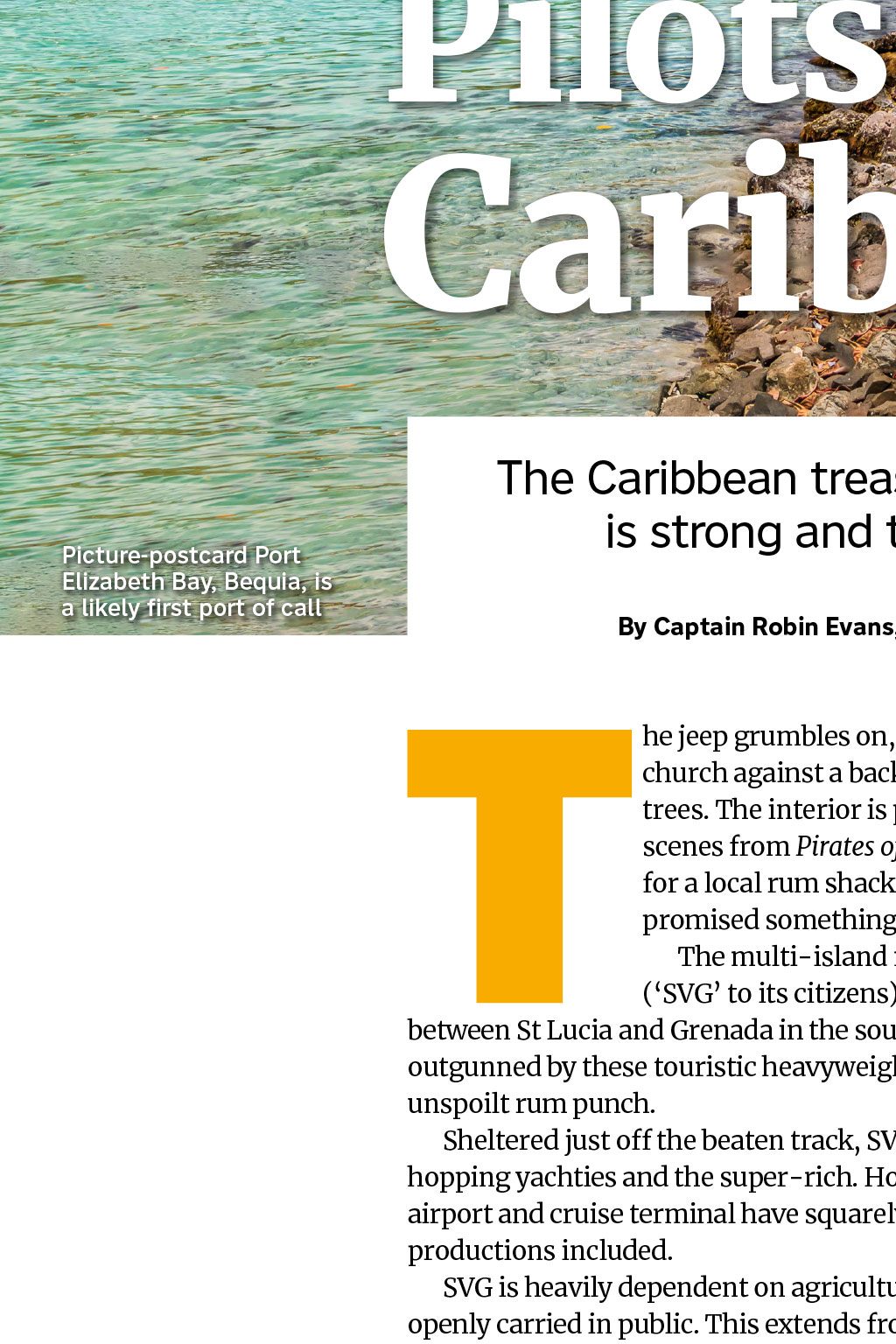

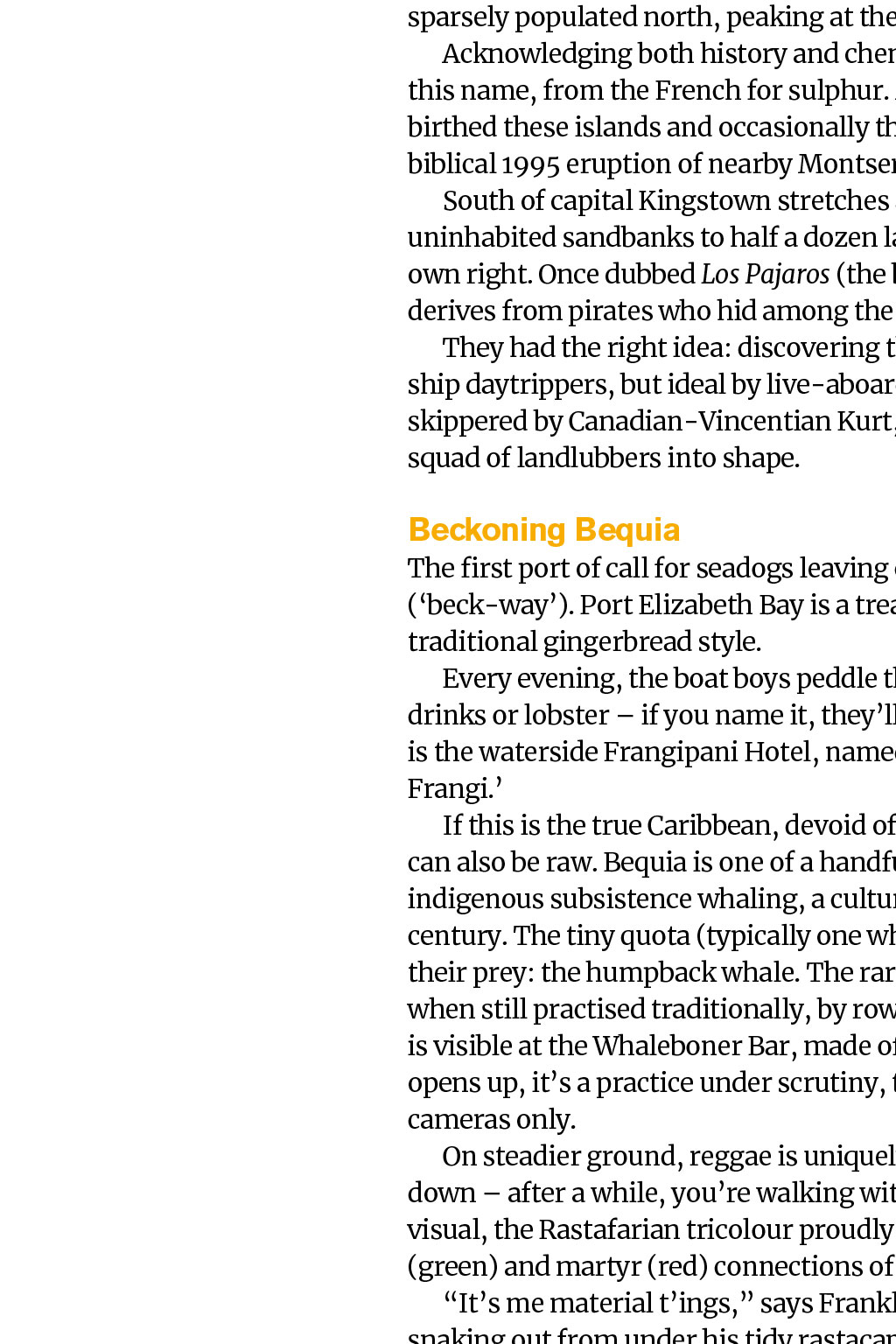
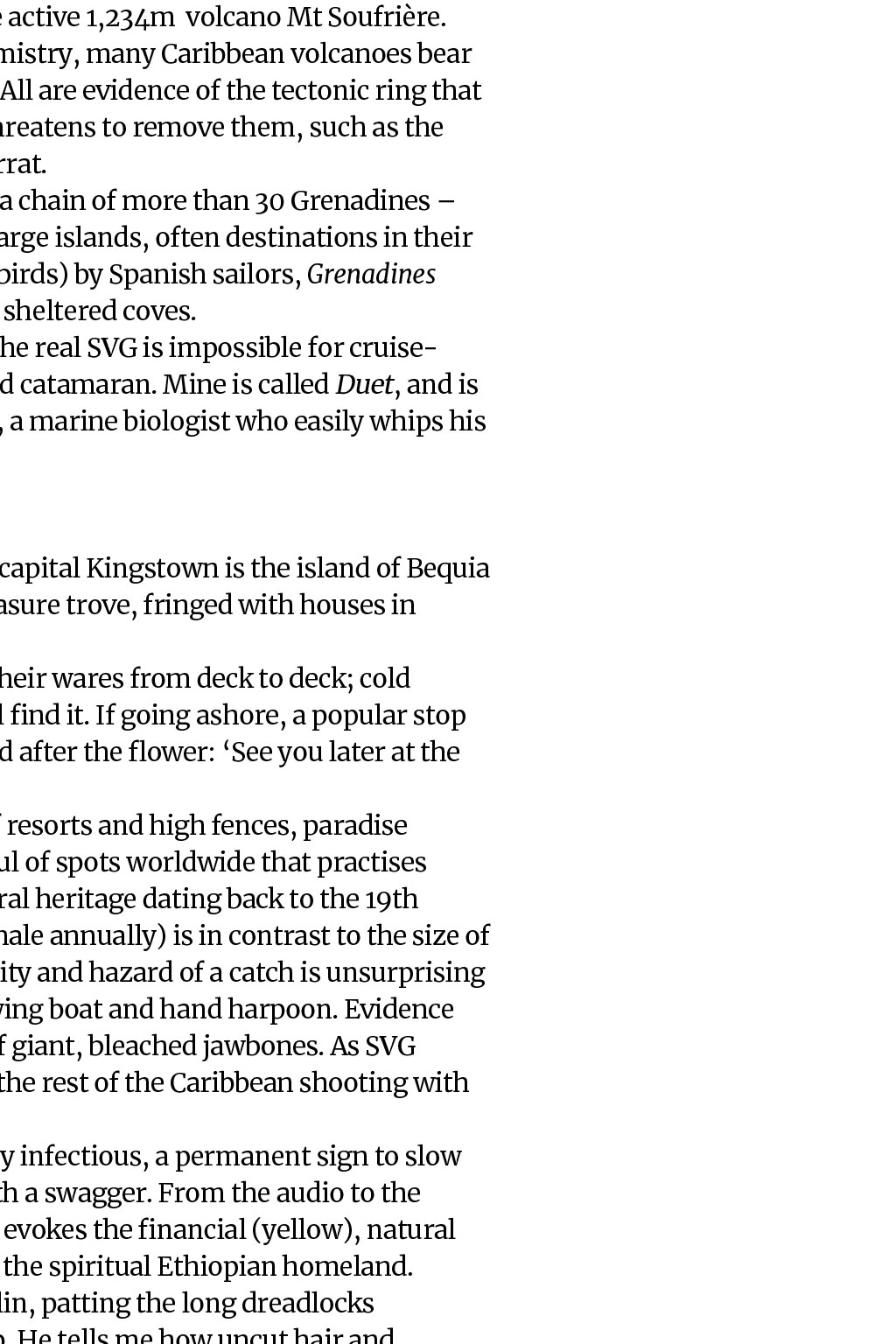
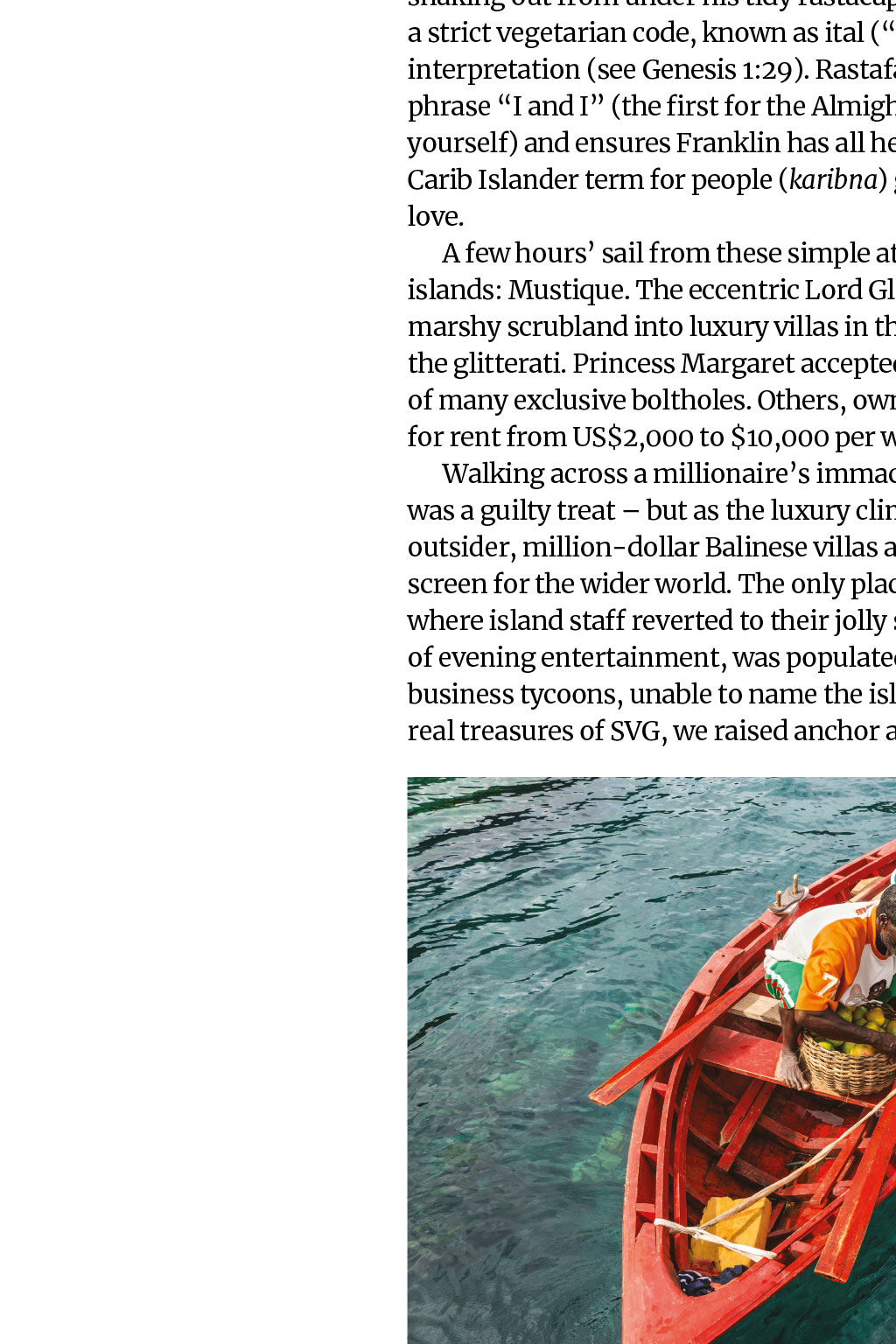
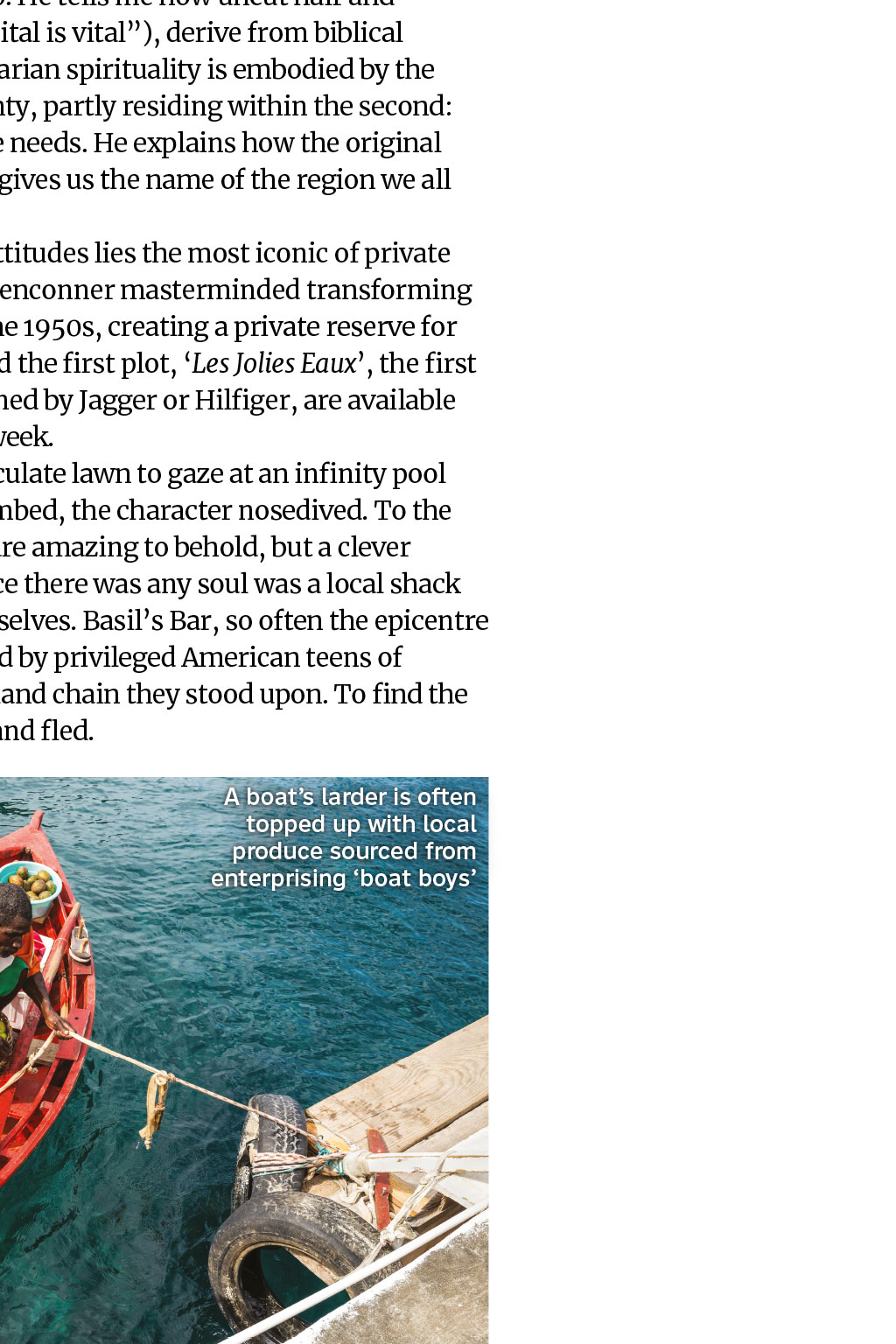
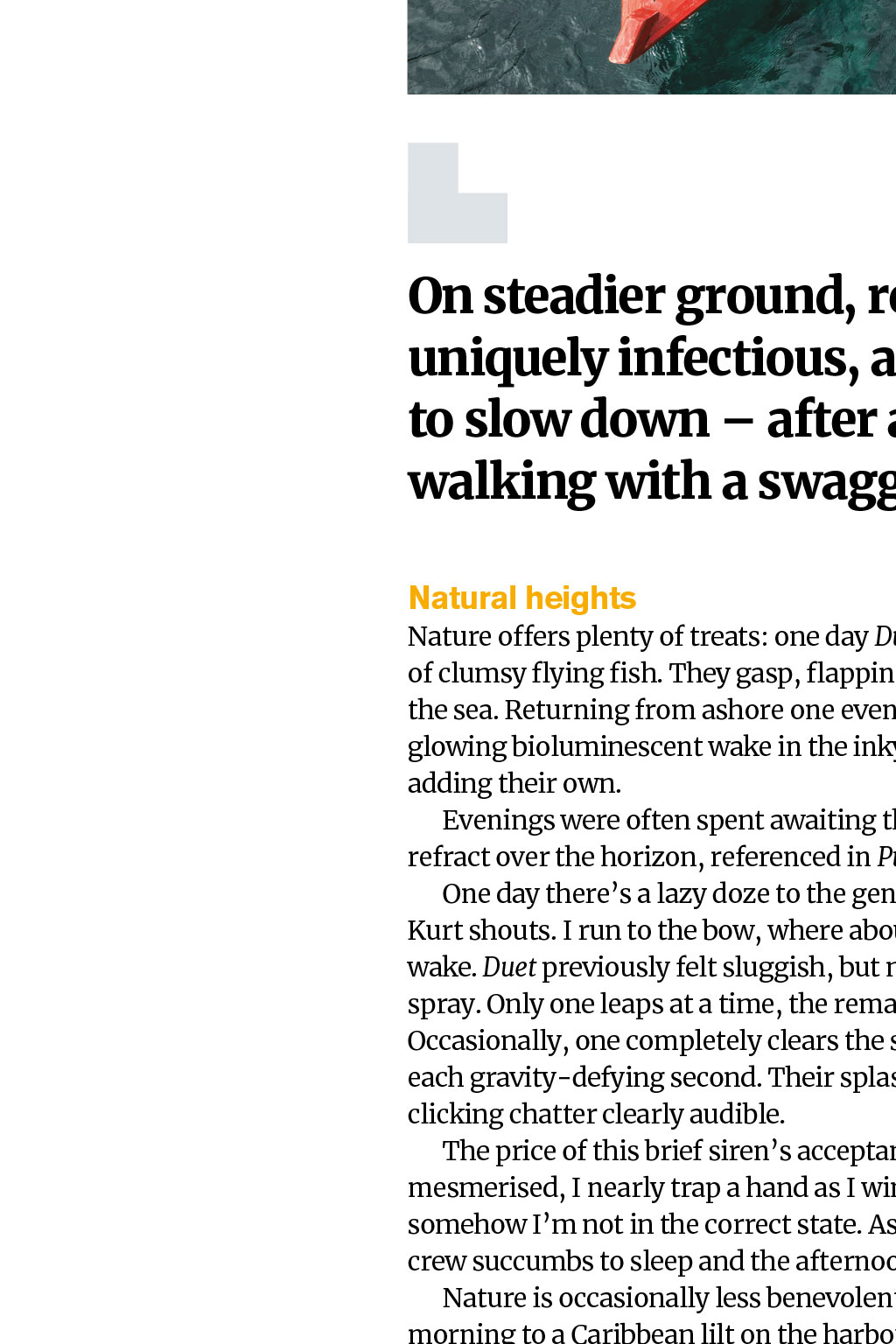
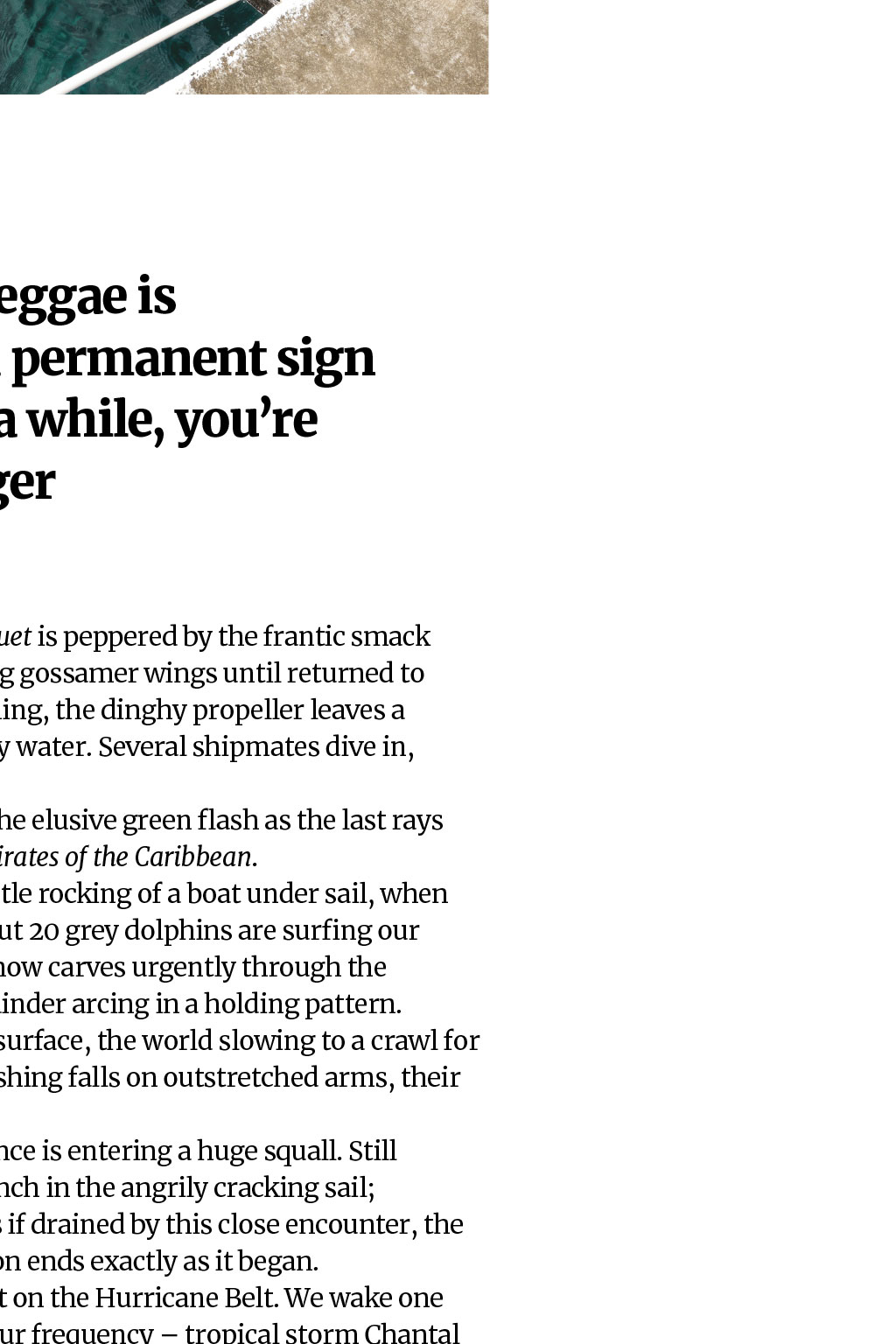

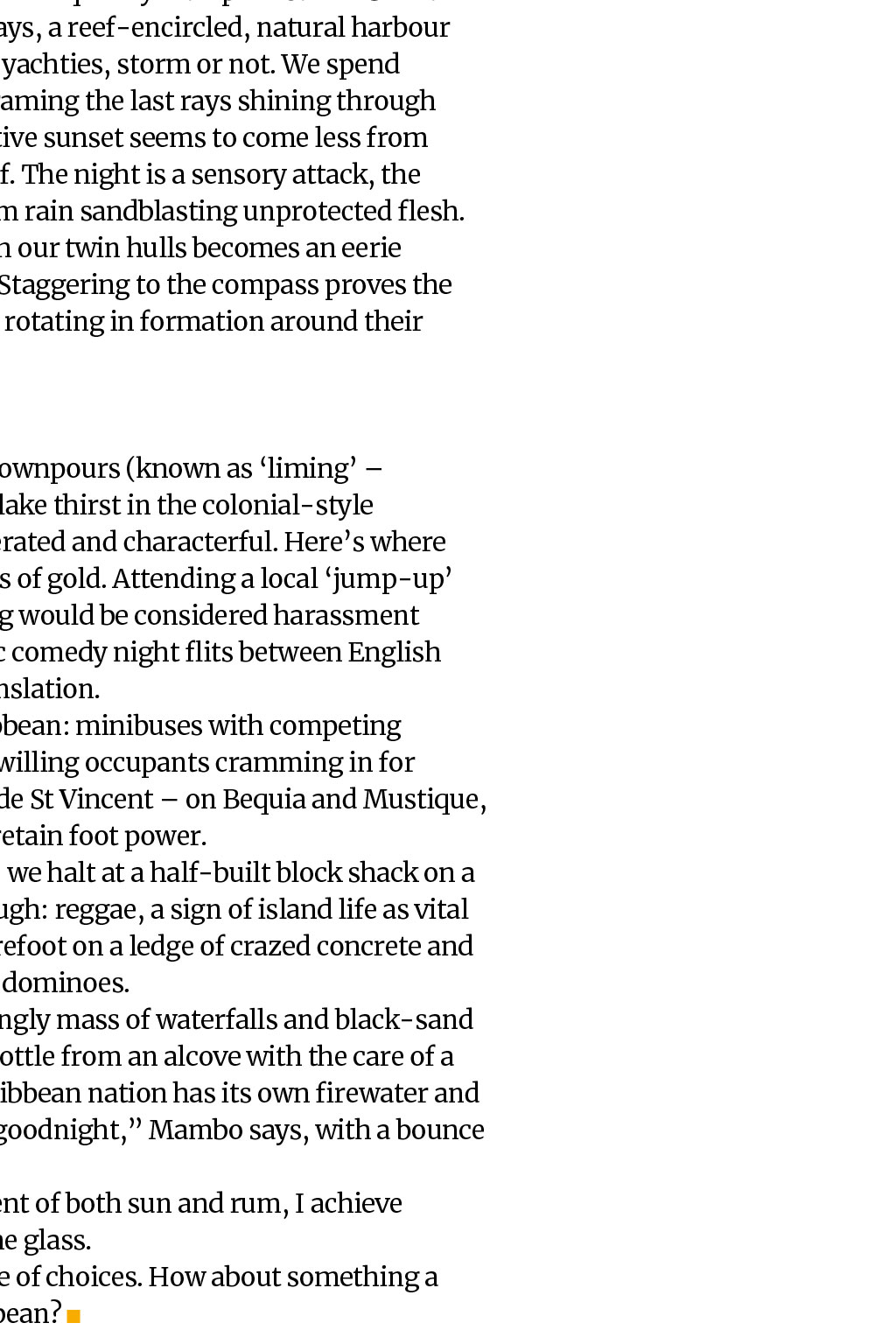

















Pilots of the Caribbean Picture-postcard Port Elizabeth Bay, Bequia, is a likely first port of call The Caribbean treasure where the rum is strong and the Wi-Fi weak By Captain Robin Evans, Senior Log Contributor he jeep grumbles on, passing the occasional clapboard church against a backdrop of steaming forest and banana trees. The interior is piratical; it makes sense that various scenes from Pirates of the Caribbean were shot here. I’d asked A boat’s larder is often topped up with local produce sourced from enterprising ‘boat boys’ Aerial view of the Tobago Cays, always a perfect bolthole, but particularly from passing storms TRAVEL for a local rum shack to say farewell to St Vincent, and been promised something unique. The multi-island nation of St Vincent and the Grenadines (‘SVG’ to its citizens) sits just west of Barbados, tucked between St Lucia and Grenada in the southern Caribbean arc. If traditionally outgunned by these touristic heavyweights, it packs a lot of character into an unspoilt rum punch. Sheltered just off the beaten track, SVG has served as a bolthole for island- hopping yachties and the super-rich. However, their secret is out; a new airport and cruise terminal have squarely planted a treasure flag – Hollywood productions included. SVG is heavily dependent on agriculture – don’t be surprised by machetes openly carried in public. This extends from bananas to less orthodox crops in the sparsely populated north, peaking at the active 1,234m volcano Mt Soufrière. Acknowledging both history and chemistry, many Caribbean volcanoes bear this name, from the French for sulphur. All are evidence of the tectonic ring that birthed these islands and occasionally threatens to remove them, such as the biblical 1995 eruption of nearby Montserrat. South of capital Kingstown stretches a chain of more than 30 Grenadines – uninhabited sandbanks to half a dozen large islands, often destinations in their own right. Once dubbed Los Pajaros (the birds) by Spanish sailors, Grenadines derives from pirates who hid among the sheltered coves. They had the right idea: discovering the real SVG is impossible for cruise- ship daytrippers, but ideal by live-aboard catamaran. Mine is called Duet, and is skippered by Canadian-Vincentian Kurt, a marine biologist who easily whips his squad of landlubbers into shape. Beckoning Bequia The first port of call for seadogs leaving capital Kingstown is the island of Bequia (‘beck-way’). Port Elizabeth Bay is a treasure trove, fringed with houses in traditional gingerbread style. Every evening, the boat boys peddle their wares from deck to deck; cold drinks or lobster – if you name it, they’ll find it. If going ashore, a popular stop is the waterside Frangipani Hotel, named after the flower: ‘See you later at the Frangi.’ If this is the true Caribbean, devoid of resorts and high fences, paradise can also be raw. Bequia is one of a handful of spots worldwide that practises indigenous subsistence whaling, a cultural heritage dating back to the 19th century. The tiny quota (typically one whale annually) is in contrast to the size of their prey: the humpback whale. The rarity and hazard of a catch is unsurprising when still practised traditionally, by rowing boat and hand harpoon. Evidence is visible at the Whaleboner Bar, made of giant, bleached jawbones. As SVG opens up, it’s a practice under scrutiny, the rest of the Caribbean shooting with cameras only. On steadier ground, reggae is uniquely infectious, a permanent sign to slow down – after a while, you’re walking with a swagger. From the audio to the visual, the Rastafarian tricolour proudly evokes the financial (yellow), natural (green) and martyr (red) connections of the spiritual Ethiopian homeland. “It’s me material t’ings,” says Franklin, patting the long dreadlocks snaking out from under his tidy rastacap. He tells me how uncut hair and a strict vegetarian code, known as ital (“ital is vital”), derive from biblical interpretation (see Genesis 1:29). Rastafarian spirituality is embodied by the phrase “I and I” (the first for the Almighty, partly residing within the second: yourself) and ensures Franklin has all he needs. He explains how the original Carib Islander term for people (karibna) gives us the name of the region we all love. A few hours’ sail from these simple attitudes lies the most iconic of private islands: Mustique. The eccentric Lord Glenconner masterminded transforming marshy scrubland into luxury villas in the 1950s, creating a private reserve for the glitterati. Princess Margaret accepted the first plot, ‘Les Jolies Eaux’, the first of many exclusive boltholes. Others, owned by Jagger or Hilfiger, are available for rent from US$2,000 to $10,000 per week. Walking across a millionaire’s immaculate lawn to gaze at an infinity pool was a guilty treat – but as the luxury climbed, the character nosedived. To the outsider, million-dollar Balinese villas are amazing to behold, but a clever screen for the wider world. The only place there was any soul was a local shack where island staff reverted to their jolly selves. Basil’s Bar, so often the epicentre of evening entertainment, was populated by privileged American teens of business tycoons, unable to name the island chain they stood upon. To find the real treasures of SVG, we raised anchor and fled. On steadier ground, reggae is uniquely infectious, a permanent sign to slow down – after a while, you’re walking with a swagger Natural heights Nature offers plenty of treats: one day Duet is peppered by the frantic smack of clumsy flying fish. They gasp, flapping gossamer wings until returned to the sea. Returning from ashore one evening, the dinghy propeller leaves a glowing bioluminescent wake in the inky water. Several shipmates dive in, adding their own. Evenings were often spent awaiting the elusive green flash as the last rays refract over the horizon, referenced in Pirates of the Caribbean. One day there’s a lazy doze to the gentle rocking of a boat under sail, when Kurt shouts. I run to the bow, where about 20 grey dolphins are surfing our wake. Duet previously felt sluggish, but now carves urgently through the spray. Only one leaps at a time, the remainder arcing in a holding pattern. Occasionally, one completely clears the surface, the world slowing to a crawl for each gravity-defying second. Their splashing falls on outstretched arms, their clicking chatter clearly audible. The price of this brief siren’s acceptance is entering a huge squall. Still mesmerised, I nearly trap a hand as I winch in the angrily cracking sail; somehow I’m not in the correct state. As if drained by this close encounter, the crew succumbs to sleep and the afternoon ends exactly as it began. Nature is occasionally less benevolent on the Hurricane Belt. We wake one morning to a Caribbean lilt on the harbour frequency – tropical storm Chantal is coming. All boats flee to the Tobago Cays, a reef-encircled, natural harbour between tiny islands and a honeypot for yachties, storm or not. We spend the evening securing Duet, her cockpit framing the last rays shining through mountains of cumulonimbus. A radioactive sunset seems to come less from the horizon than through the water itself. The night is a sensory attack, the deck lighting savaging eyes and the warm rain sandblasting unprotected flesh. Each boiling whitecap exploding beneath our twin hulls becomes an eerie reverberation that makes Duet shudder. Staggering to the compass proves the epicentre of Chantal is passing, all boats rotating in formation around their anchors. Rum diaries Exploring Kingstown between intense downpours (known as ‘liming’ – enjoying downtime for its own sake), I slake thirst in the colonial-style Cobblestone Inn. The local culture is liberated and characterful. Here’s where a local guide is worth his weight in pieces of gold. Attending a local ‘jump-up’ (party) Kurt explains: “Here, the dancing would be considered harassment anywhere else.” Next door, an open-mic comedy night flits between English and the local patois, tricky without a translation. The public transport is typically Caribbean: minibuses with competing custom paint jobs, soft furnishings and willing occupants cramming in for a jolly commute. There are no cars outside St Vincent – on Bequia and Mustique, they use buggies, while smaller islands retain foot power. Returning to the jeep-based farewell, we halt at a half-built block shack on a steep ledge. A familiar pulse bleeds through: reggae, a sign of island life as vital as any wave-lapped beach. We perch barefoot on a ledge of crazed concrete and soak it in. A couple of locals throw down dominoes. Behind lies windward St Vincent: a jungly mass of waterfalls and black-sand beaches. Mambo the proprietor pulls a bottle from an alcove with the care of a sniper selecting a prize round. Every Caribbean nation has its own firewater and this is SVG’s. “We call it sunset ’cos it’s goodnight,” Mambo says, with a bounce that sets his dreadlocks swaying. It’s authentic, but watching the descent of both sun and rum, I achieve balance: what matters most is outside the glass. As an island metaphor, you’ve a range of choices. How about something a little different for the pilots of the Caribbean? St Vincent capital Kingstown, looking south towards the Grenadines Volcanic Sandy Bay, on St Vincent’s windward coast Bequia’s Moonhole, a partially abandoned colony of rock homes Location: sandwiched between touristic heavyweights in the Southern Caribbean Local hangout and Rastafarian shrine: Robert Righteous on the island of Mayreau Pilots of the Picture-postcard Port Elizabeth Bay, Bequia, is a likely first port of call TRAVEL Picture-postcard Port Elizabeth Bay, Bequia, is a likely first port of call Pilots of the Caribbean TRAVEL